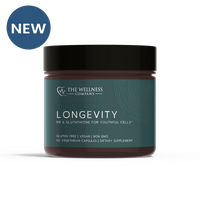Sunlight and Skin Health: How to Reap Vitamin D Rewards While Dodging Sun Damage

Summer is not just a season of beach days and barbecues, but a golden opportunity to get your fill of a crucial molecule in which 42% of Americans are deficient: vitamin D. While the summer sun offers us a natural vitamin D boost, it also brings with it the risk of skin damage. In today’s article, we’ll be exploring why vitamin D is so essential, how much sun is needed to achieve adequate levels, and how to strike a balance to ensure you get all the benefits without incurring the costs.
The Vital Role of Vitamin D
Vitamin D plays a pivotal role in our health and wellness. It aids in the absorption of calcium, promoting bone health and reducing the risk of brittle bone diseases like osteoporosis. It also bolsters our immune system, enhancing both innate and adaptive immunity. Research even suggests that vitamin D helps regulate our mood, and may play a role in warding off depression.
The consequences of vitamin D deficiency are severe. Low levels have been linked to a slew of health concerns, such as:
- Increased risk of autoimmune disease, and increased susceptibility to illness.
- Chronic fatigue.
- Low bone density.
- Depression or other mood disorders.
- Impaired wound healing.
- Hair loss.
Given the potential risks of vitamin D deficiency, it's clear that ensuring adequate vitamin D levels should be a priority for all of us.
Why Latitude Matters
Our skin synthesizes vitamin D when exposed to the sun. Specifically, ultraviolet B (UVB) rays convert a type of cholesterol in the skin to a precursor of vitamin D. This process is most efficient during the summer, especially in regions closer to the equator, where UVB rays are more direct.
In areas farther from the equator, however, UVB rays are scarcer. This results in lower skin production of vitamin D, making the sunny days of summer even more vital for those living in these higher latitudes.
A Balancing Act: Vitamin D and Sun Exposure
While the prospect of basking in the sunshine for hours on end might seem tempting, it brings up an essential question: how much sun is enough, and how much is too much?
Skin synthesizes vitamin D fairly quickly, especially in fair-skinned individuals. In fact, spending just 10-15 minutes in direct sunlight, several times a week, is enough for many people. However, the duration needed to reach adequate levels varies based on skin tone, with darker skin requiring more sun exposure to produce the same amount of vitamin D.
The only way to know precisely whether you’re doing too much or too little, of course, is to have your vitamin D levels tested, and to adjust your habits based on your results. If you’re not able to safely reach adequate levels of vitamin D via sun exposure, consider TWC's vitamin D supplement to ensure you are covering your bases.
The Double-Edged Sword: Sun Exposure and Melanoma
Sunshine, while essential for vitamin D production, can also lead to DNA damage in skin cells, a primary factor in skin cancers, including melanoma. When UV rays interact with skin cells, they can induce mutations. Over time, and with continued sun damage, these mutations accumulate, increasing the risk of skin cancer.
While a sunburn might seem like a harmless inconvenience, its effect over the long-term are not so benign.
A Guided Approach to Safe Sunning
Harness the summer sun for vitamin D by:
- Timing Your Exposure: The sun is most intense between 10 a.m. and 4 p.m. Aim for short bursts of direct exposure during these hours.
- Using Protection: Wear a broad-spectrum sunscreen of at least SPF 30 to block harmful rays, and reapply often.
- Dressing Smart: Wear protective clothing, including wide-brimmed hats and UV-blocking sunglasses.
- Seeking Shade: Even during your sun sessions, it’s wise to alternate between sunlight and shade.
- Fortifying Your Skin Health: TWC’s Hair, Skin and Nail Gummies, a formula designed to fortify your body's collagen production and bolster its defenses against harmful UV rays from the sun.
The Bottom Line
Summer sunshine is a double-edged sword: a natural source of essential vitamin D and a potential risk for skin damage. Ensuring adequate vitamin D levels is vital for overall health, from immunity to bone strength to mood regulation. Yet, it's crucial to remember that for many of us, only brief sun exposure is required to achieve this. As with most things in life, balance is key. Embrace the sun's benefits responsibly but be sure to safeguard your skin while soaking in the rays.
References
Bikle, D. D. (2012). Vitamin D and bone. Current osteoporosis reports, 10, 151-159.
Aranow, C. (2011). Vitamin D and the immune system. Journal of investigative medicine, 59(6), 881-886.
Wilkins, C. H., Sheline, Y. I., Roe, C. M., Birge, S. J., & Morris, J. C. (2006). Vitamin D deficiency is associated with low mood and worse cognitive performance in older adults. The American journal of geriatric psychiatry, 14(12), 1032-1040.














